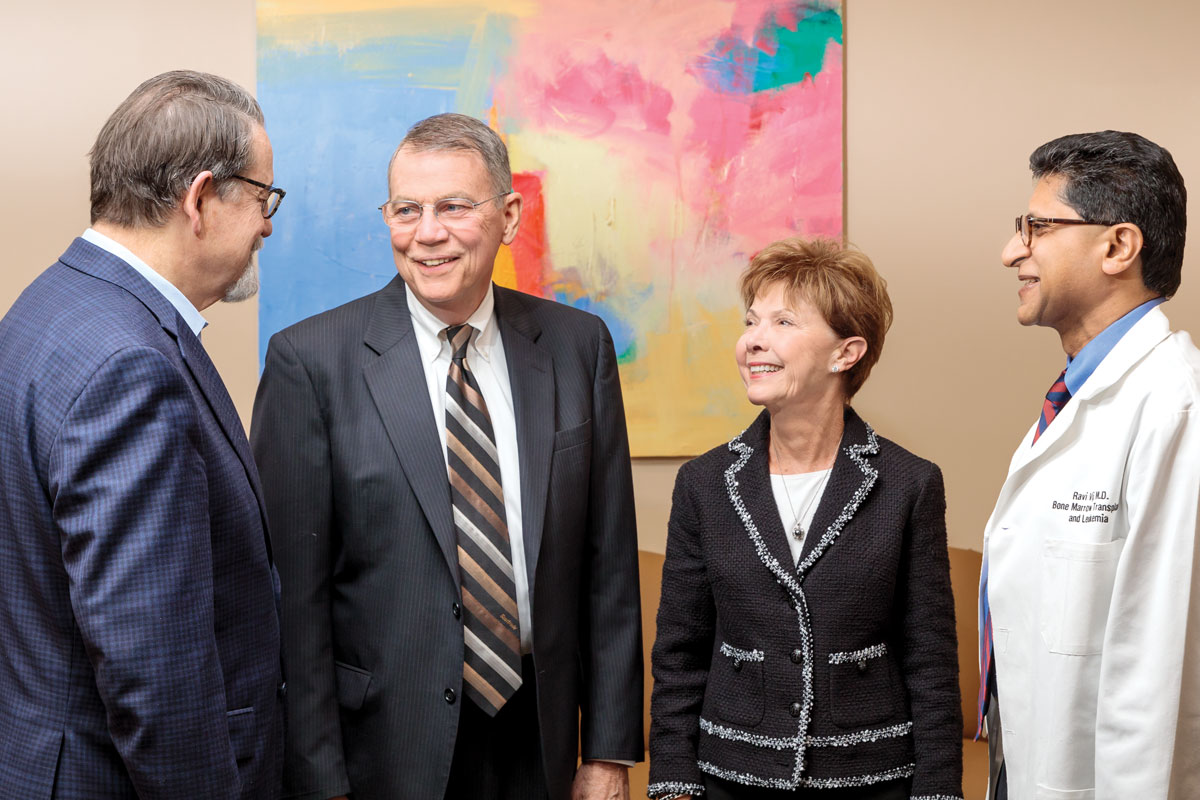
Rodger and Paula Riney, center, recently came to campus to meet with oncology leaders. Above, the Rineys greet John DiPersio, MD, PhD, left, deputy director of Siteman Cancer Center, and Ravi Vij, MD, Rodger Riney’s physician and principal investigator on three multiple myeloma studies.
Multiple myeloma remains largely incurable for most patients, despite improvements in treatment options. The blood cancer, which affects the plasma cells of bone marrow, takes the lives of 11,000 Americans each year. Now, a $20 million gift from Rodger Riney and his wife, Paula, is bringing hope to those afflicted — including Riney himself.
The Paula C. and Rodger O. Riney Blood Cancer Research Initiative Fund supports efforts of physicians and scientists at Alvin J. Siteman Cancer Center at Barnes-Jewish Hospital and Washington University School of Medicine. Together, this multidisciplinary team has broad expertise in multiple myeloma, genomics, immunology and immunotherapy, imaging and pharmacogenomics.
The gift provides investigators with crucial seed funding to conduct research and generate early data so that they can apply for larger federal grants. Effectively competing for these grants requires that the hypotheses first be validated to some degree.
“We just need the resources to be able to develop this,” said Ravi Vij, MD, professor of medicine in the Division of Oncology and Rodger’s physician. “And this gift provides us a resource to develop it.”
Currently, the gift provides continued funding for three studies. An earlier $5 million gift in 2016 from the Rineys provided start-up funding for the studies. The research aims to:
- Refine a promising immunotherapy technique called CAR-T cell therapy and apply it to multiple myeloma.
- Classify the genes and proteins of multiple myeloma patients and mine the data to identify inherited susceptibility and treatment options.
- Use a unique, 3-D tissue-engineered bone marrow created from individual patient cells to screen medications for personalized treatment. Washington University is the only institution using the patient’s bone marrow microenvironment and own stem cells in a 3D model, Vij said.
Diagnosed with cancer
Following his diagnosis in 2015 at the age of 69, Kirkwood native Rodger Riney approached the disease with the same type of business acumen that has served him well throughout his successful career. Riney founded the brokerage firm Scottrade in 1980 and held the position of CEO until its sale to TD Ameritrade in 2017.
He turned to Siteman for treatment, where he and Paula delved into learning as much as possible about the disease and available options. The information was more daunting than he expected. While new drugs have been approved for treatment in recent years, results have varied widely. Some patients respond well, while others don’t respond at all — and the reason for the discrepancy isn’t clear. Even for those patients who experience remission, treatment rarely cures the disease, and the median life expectancy today is eight to 10 years.
“So our answer was, we should get more involved. We should do more for research and get something done now,” Riney said. “I have a vested interest in a cure in four years, not a cure in 40 years. So I’m trying to do that and hope that others will too.”
Riney is eager to make a difference for himself and the 30,000 Americans diagnosed yearly — and Washington University, a leading multiple myeloma research center, is the right place to make it happen, he said. In 2015, the National Cancer Institute awarded university researchers $13.7 million, spurring creation of the Center for Multiple Myeloma Nanotherapy.
“I feel fortunate to be under the care of their physicians and researchers, and proud to invest in the advancement of leading-edge research.” – Rodger Riney
“Within two or three visits with me, he (Riney) began asking about multiple myeloma research,” Vij said. “He wanted to know if he could help advance our work.”
Rodger and Paula soon met with David H. Perlmutter, MD, executive vice chancellor for medical affairs and the George and Carol Bauer Dean of the School of Medicine.
“Yes, these are the kinds of resources that can spur the most imaginative and innovative approaches,” Perlmutter said. “But also, Paula and Rodger have given us the kind of passion and vision to pursue our best ideas with urgency and profound purpose.
Becoming an advocate
In the three years since the diagnosis, Rodger has become an advocate for multiple myeloma research and treatment. He serves as a member of the board of directors for the Multiple Myeloma Research Foundation, and also has participated in clinical trials at Siteman, including a study comparing the efficacy of two drug regimens in halting disease progression.
The Rineys, longtime community and nonprofit leaders who also support Alzheimer’s and Parkinson’s disease research at Washington University, have found that multiple myeloma lacks funding compared to many better-known cancers. They saw an opportunity to make an impact on human health that could affect their own lives as well as many generations to come.
“I certainly hope our children and grandchildren won’t have to worry about this disease,” Paula said.
They are happy to see that impact take shape in their own community.
“Siteman and Washington University are gems to have in St. Louis,” Rodger said. “I feel fortunate to be under the care of their physicians and researchers, and proud to invest in the advancement of leading-edge research.”
Mary Lee and Julia Evangelou-Strait contributed to this story.
Published in the Spring 2019 issue


